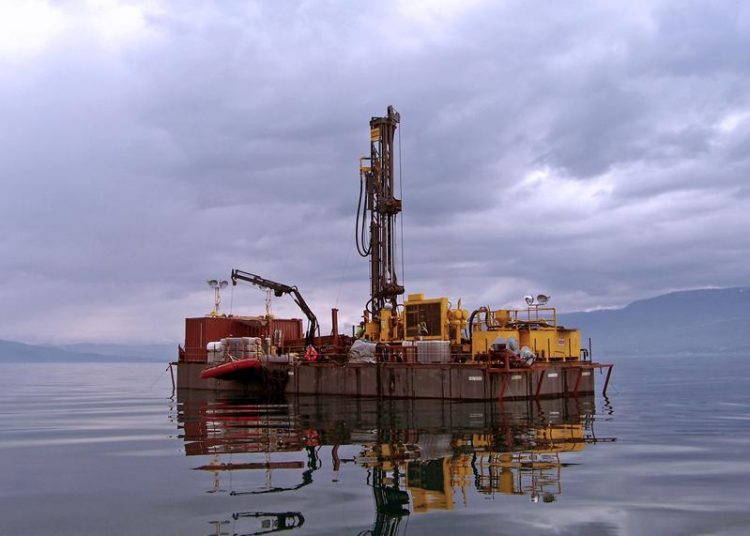Oldest European lake reveals its secrets

The drilling platform lay on Lake Ohrid for several weeks. An international research team carried out various drillings and measurements. LIAG/T.Grelle
In 2013, the international research team with LIAG participation began its investigations on Lake Ohrid between Macedonia and Albania. Researchers from various European countries drilled 568 metres into the sediment layers below the lake.
Five more years and various geological, chemical and physical analyses were needed to unlock the secrets of the sediments at the bottom of Lake Ohrid. Now, the research team was able to publish its results within the scientific journal “nature”.
Lake Ohrid is exactly 1.36 million years old and has experienced several warm and ice ages. Geochemical data and pollen findings show that it rained more heavily in the northern Mediterranean during the warm periods. The intensive rainfall occurred mainly in autumn. Due to the warm sea surface and the influx of humid Atlantic air masses, pronounced low-pressure areas developed in the northern Mediterranean.
These phenomena may be repeated in the Mediterranean region in the face of man-made climate change. In its regular reports, the Intergovernmental Panel on Climate Change (IPCC) not only summarizes the state of scientific knowledge on climate change, but also forecasts the consequences of global warming for individual areas.
The IPCC's forecasts for the Mediterranean region do not provide a clear picture. With the findings from drilling in Lake Ohrid, researchers are now able to calculate more reliable scenarios for the Mediterranean region.
“What is special about Lake Ohrid is that it has hardly been disturbed by external influences in the last 1.4 million years,” says Dr. Thomas Wonik, department head at LIAG and part of the international research team. The lake has never completely dried up, nor have catastrophic events distorted the geological picture.
That's why the researchers can reconstruct the local climate history very precisely. One approach is to compare the natural radioactivity of sediments with global climate reference curves. These curves show the cyclical climate history of the last five million years.
The sediments from Lake Ohrid highly correlate with the results of the global climate reference curve and show the same variations between ice ages and interglacial warm periods. “Rarely in geophysics can we read the dynamics of warm and cold periods so precisely from physical borehole measurements as in the case of Lake Ohrid,” says Wonik.
Dr. Thomas Wonik
0511-643 3517
Thomas.Wonik@leibniz-liag.de
https://doi.org/10.1038/s41586-019-1529-0
https://rdcu.be/bP6ID (view-only version of the paper)
Media Contact
More Information:
http://www.leibniz-liag.deAll latest news from the category: Earth Sciences
Earth Sciences (also referred to as Geosciences), which deals with basic issues surrounding our planet, plays a vital role in the area of energy and raw materials supply.
Earth Sciences comprises subjects such as geology, geography, geological informatics, paleontology, mineralogy, petrography, crystallography, geophysics, geodesy, glaciology, cartography, photogrammetry, meteorology and seismology, early-warning systems, earthquake research and polar research.
Newest articles

High-energy-density aqueous battery based on halogen multi-electron transfer
Traditional non-aqueous lithium-ion batteries have a high energy density, but their safety is compromised due to the flammable organic electrolytes they utilize. Aqueous batteries use water as the solvent for…

First-ever combined heart pump and pig kidney transplant
…gives new hope to patient with terminal illness. Surgeons at NYU Langone Health performed the first-ever combined mechanical heart pump and gene-edited pig kidney transplant surgery in a 54-year-old woman…

Biophysics: Testing how well biomarkers work
LMU researchers have developed a method to determine how reliably target proteins can be labeled using super-resolution fluorescence microscopy. Modern microscopy techniques make it possible to examine the inner workings…





















